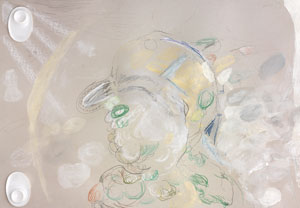Yitzhak Golombek | Carriages

Yitzhak Golombek’s sculpture may be termed sculpture in the first person. Even in the simple sense of the objects’ basic corporeality, but more so due to the speaking “self” who turns directly to the viewer, including himself in the sculptural sentence… The return of the drop is all but accidental. In fact, Golombek works with a well-defined, exclusive lexicon of images which he has compiled over the years. It is as though he must “sleep on” every new image, a hibernation rife with deliberations, before he lets it in, but once the image is admitted, it is embraced with boundless loyalty. Strawberries, as the well-known literary hedgehog Shmulik (Shmulik-Kipod) learnt from personal experience, cling to you if you go to bed with them.
Known and valued as they may be, the drawings have never been exhibited independently before. They were only presented as a by-product, as preliminary studies for sculptures, as part of the work process. Here, it seems as though the drawings were, for the first time, conceived as such. Executed in graphite and chalk, they appear so fragile, like dust-marks liable to disappear with the breath of a heedless viewer. The influences are discernible: a line of Israeli draftsmen, from Ticho, Aroch, and Uri to Lavie, but also others, such as Philip Guston. Nevertheless, the key motif in this body of drawings is a face made of vegetables, fruits, and foodstuffs… Since Golombek has long explored the way in which the whole is created from its constituent details, a reference to the portraits of 16th century Italian artist Giuseppe Arcimboldo seems almost natural.
Vis-á-vis the Italian excess and wealth, which correspond with the tradition of Vanitas, however, Golombek introduces a contrasting option of frugality and dryness. Something new and significant happens here: the merry portrait of the Italian artist is forced to recount a moving story about the artist’s father, a Holocaust survivor who, in the drawings, becomes an archetypical survivor who goes to sleep with food under the pillow and wakes up with food stuck to his face.
From: Guy Ben Ner, “A Two-Drop Flood”